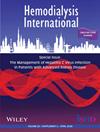Longitudinal micro-incision creation prior to balloon angioplasty for treatment of arteriovenous access dysfunction in a real-world patient population: 6-month cohort analysis
Abstract
Introduction
Routine hemodialysis depends on well-functioning vascular access. In the event of vascular access dysfunction, percutaneous transluminal balloon angioplasty (PTA) is conducted to restore patency. Although an angioplasty procedure can provide an excellent immediate result by opening the access to allow dialysis to continue, the long-term patency rates are less than satisfactory. The goal of this study was to assess the outcomes of patients who underwent a novel vessel preparation via longitudinal, controlled-depth micro-incisions prior to PTA.
Methods
This multicenter, prospective, observational registry enrolled hemodialysis patients scheduled to undergo PTA of their arteriovenous fistula or graft due to clinical or hemodynamic abnormalities. A primary endpoint was anatomic success, defined as angiographic confirmation of <30% residual stenosis post-procedure without an adverse event. Additional assessments included device technical success, clinical success, freedom from target lesion revascularization, target lesion primary patency, and circuit primary patency at 6 months.
Findings
A total of 148 lesions were treated with the FLEX Vessel Prep™ System (FLEX VP) prior to PTA in 114 subjects at eight clinical sites. Target lesions were 21 ± 25 mm in length with mean pre-procedure stenosis of 75.2% ± 4.7%. Five procedural complications were recorded without serious adverse events. Two subjects did not complete the follow-up evaluation. Target lesion primary patency across all subjects at 6-months was 62.2% with mean freedom from target lesion revascularization of 202.7 days. Target lesion primary patency and freedom from target lesion revascularization for AVF cases (n = 72) were 67.5% and 212.9 days, respectively. Target lesion primary patency and freedom from target lesion revascularization for AVGs (n = 42) were 52.4% and 183.3 days, respectively. In cases treating AVF cephalic arch stenosis (n = 25), 6-month target lesion primary patency was 70.6% and freedom from target lesion revascularization was 213.4 days.
Discussion
This FLEX-AV registry demonstrates safety and effectiveness, notably in the cephalic arch and AVGs, when FLEX VP is used prior to PTA for treatment of vascular access dysfunction in a population of end-stage renal disease subjects.


 求助内容:
求助内容: 应助结果提醒方式:
应助结果提醒方式:


